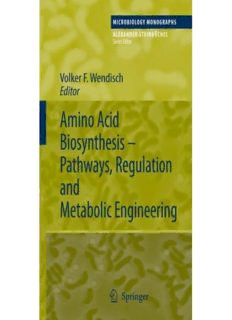Table Of Content5
Microbiology Monographs
SeriesEditor:Alexander Steinbüchel
MicrobiologyMonographs
Volumespublishedintheseries
InclusionsinProkaryotes
JessupM.Shively(Editor)
Volume1(2006)
ComplexIntracellularStructuresinProkaryotes
JessupM.Shively(Editor)
Volume2(2006)
MagnetoreceptionandMagnetosomesinBacteria
DirkSchüler(Editor)
Volume3(2007)
PredatoryProkaryotes–Biology,EcologyandEvolution
EdouardJurkevitch(Editor)
Volume4(2007)
Amino Acid Biosynthesis –
Pathways, Regulation
and Metabolic Engineering
Volume Editor: Volker F. Wendisch
With64Figures,6inColor
123
VolumeEditor:
Prof.Dr.VolkerF.Wendisch
InstituteofMolecularMicrobiologyandBiotechnology
WestfalianWilhelmsUniversityMünster
Corrensstr.3
48149Münster
Germany
e-mail:[email protected]
SeriesEditor:
ProfessorDr.AlexanderSteinbüchel
InstitutfürMolekulareMikrobiologieundBiotechnologie
WestfälischeWilhelms-Universität
Corrensstraße3
48149Münster
Germany
e-mail:[email protected]
LibraryofCongressControlNumber:2006940356
ISSN1862-5576
ISBN978-3-540-48595-7SpringerBerlinHeidelbergNewYork
DOI10.1007/978-3-540-48596-4
Thisworkissubjecttocopyright.Allrightsarereserved,whetherthewholeorpartofthematerial
isconcerned,specificallytherightsoftranslation,reprinting,reuseofillustrations,recitation,broad-
casting,reproductiononmicrofilmorinanyotherway,andstorageindatabanks.Duplicationof
thispublicationorpartsthereofispermittedonlyundertheprovisionsoftheGermanCopyrightLaw
ofSeptember9,1965,initscurrentversion,andpermissionforusemustalwaysbeobtainedfrom
Springer.ViolationsareliableforprosecutionundertheGermanCopyrightLaw.
SpringerisapartofSpringerScience+BusinessMedia
springer.com
(cid:1)c Springer-VerlagBerlinHeidelberg2007
Theuseofregisterednames,trademarks,etc.inthispublicationdoesnotimply,evenintheabsence
ofaspecificstatement,thatsuchnamesareexemptfromtherelevantprotectivelawsandregulations
andthereforefreeforgeneraluse.
Editor:Dr.ChristinaEckey,Heidelberg,Germany
DeskEditor:Dr.JuttaLindenborn,Heidelberg,Germany
CoverDesign:WMXDesignGmbH,Heidelberg,Germany
TypesettingandProduction:LE-TEXJelonek,Schmidt&VöcklerGbR,Leipzig,Germany
Printedonacid-freepaper SPIN11768746 149/3100YL–543210
Preface
Amino acids are simple organic compounds containing at least one amino
and one carboxylic function. The L-α-amino acids and glycine can be con-
sideredbuilding blocksoflifesincetheyconstitutethebiopolymers proteins
in all organisms, but also D-isomers, e.g. D-alanine in bacterial cell walls,
and β- and γ-amino acids like β-alanine as component of vitamin B5 and
γ-aminobutyrateasneurotransmitteroccurinnature.Whilematureproteins
contain many different amino acids due to post-translational modifications,
only 22 proteinogenic L-α-amino acids are genetically encoded, i.e. they are
used for protein biosynthesis as amino acyl-tRNAs by the ribosome. Since
the deciphering of the genetic code for 20 amino acids about 40 years ago,
L-selenocysteine(Chambersetal.1986;Zinonietal.1986)andL-pyrrolysine
(Haoetal.2002; Srinivasanetal.2002)werediscoveredasthe21stand22nd
geneticallyencodedaminoacids.Theco-translationalinsertionofselenocys-
teine and pyrrolysine into nascent proteins requires unique cis- and trans-
actingfactorstorecodeUGAandUAGstopcodons,respectively,ascodonsfor
selenocysteine and pyrrolysine, respectively. The existence of further widely
distributed and genetically encoded amino acids is unlikely as suggested in
arecentbioinformaticanalysisoftRNAsencodedinabout150bacterialandar-
chaealgenomes(Lobanovetal.2006).TheessentialL-aminoacidsisoleucine,
leucine,lysine,methionine,phenylalanine,threonine,tryptophan,andvaline
cannotbesynthesizedbyhumans,buthavetosuppliedinthediet,andinfants
requirearginineandhistidineinaddition.Microorganismsdifferconsiderably
intheircapabilitiestosynthesizeaminoacidsdenovo,forexampleLeuconos-
tocmesenteroidesonlygrows,when16aminoacidsaresupplied,whilebacteria
likeEscherichiacoli,BacillussubtilisandCorynebacteriumglutamicumareable
tosynthesizeallaminoacidsdenovofromammonium.
This monograph deals with amino acid biosynthetic pathways and their
geneticandbiochemicalregulationononehandandwiththeuseandmetabolic
engineeringofmicroorganismsforbiotechnologicalproductionofaminoacids
onthe other. The current knowledge of amino acid metabolic pathways and
transportsystemsspecificforuptakeorexportofaminoacidsiscovered.
Thecharacterizationofthecontrolmechanismsofaminoacidbiosynthesis
haverevealed fundamental insights into genetic and biochemicalregulation.
Feedbackinhibitionofbiosyntheticenzymesbymetabolicend-products(e.g.
VI Preface
ofaspartatetranscarbamoylaseinthebiosynthesisofarginineandpyrimidines
by CTP), enzyme activity controlby covalent modification (e.g. adenylation
of glutamine synthetase), co-repressor dependent transcriptional repression
(e.g. by the tryptophan-activated repressor of the trp operon), and attenua-
tioncontrol(e.g.translation-mediated attenuationofthetryptophanbiosyn-
thetic operon)are integral partsof biochemistry, genetics and microbiology
textbooks.Recently,globalgeneexpressionanalysesalloweddeterminingthe
regulonsofanumberoftranscriptionalregulatorsofaminoacidbiosynthesis.
Moreover,thediscoveryofalysine-specific riboswitch(Sudarsanetal.2003),
anewclassofregulatoryelements, illustratesthatthecharacterizationofthe
regulationofaminoacidmetabolismcontinuestospurnewdiscoveries.
Aminoacidsareusedonthebasisoftheirchemicalcharacteristics,physi-
ologicalactivities,nutritionalvalueandtasteaschemicalbuilding blocks,as
pharmaceuticalsand,particularly,asfoodandfeedadditives.Thediscoveryof
C.glutamicumassuitablecatalysttoproducetheflavorenhancermonosodium
glutamate1957inJapanmarkedthebirthoftheaminoacidfermentationin-
dustry.Reportsonthebeginningsofmicrobialaminoacidproduction(Yamada
et al. 1972; Aida et al. 1986; Enei et al. 1989) and an up-to-date review of C.
glutamicum (Eggeling & Bott 2005) are available. In this monograph, recent
achievementstoenableortoimproveproductionofaminoacidsandofdipep-
tidesbyfermentationandenzymecatalysisarecomprehensivelyreviewedwith
aparticularfocusonmetabolicengineering, i.e.therationalimprovementof
acell’smetabolicfunctionsusingrecombinant DNAtechnology.Genomese-
quencing and post-genomics approaches to strain improvement for amino
acidproductionwillbecoveredastheirimpact,althoughalreadyquitevisible,
isexpectedtoincreaseconsiderablyinthefutureacceleratingthedevelopment
ofnewandmoreefficientbiocatalystsforaminoacidproduction.
We are grateful to the authors who contributed excellent chapters to the
volume Amino Acids – Pathways,Regulation and Metabolic Engineering. We
highly appreciate the expertise and enthusiasm devoted to their chapters.
Despitetheirmanyotherobligationsanddutiestheircomprehensiveoverview
chaptersweretimelycompleted.OurthanksalsogotoSpringerforpublishing
this monograph and especially to Christina Eckey and Jutta Lindenborn for
theirvaluablesuggestionsandsupport.
Münster,January2007 VolkerF.Wendisch
AlexanderSteinbüchel
Preface VII
References
AidaK,ChibataI,NakayamaK,TakinamiK,YamadaH(1986) BiotechnologyofAmino
AcidProduction.ProgressinIndustrialMicrobiology.KodanshaLtd,TokyoandElsevier,
Amsterdam–Oxford–NewYork–Tokyo
ChambersI,FramptonJ,GoldfarbP,AffaraN,McBainW,HarrisonPR(1986)Thestructure
ofthemouseglutathioneperoxidasegene:theselenocysteineintheactivesiteisencoded
bythe‘termination’codon,TGA.EMBOJ5:1221–1227
EggelingL,BottM(2005)HandbookofCorynebacteriumglutamicum.CRCPress(Taylor
FrancisGroup),BocaRaton
Enei H,Yokozeki K,AkashiK (1989) Recent progress inmicrobialproductionof amino
acids.GordonandBreach,Amsterdam
HaoB,GongW,FergusonTK,JamesCM,KrzyckiJA,ChanMK(2002)AnewUAG-encoded
residueinthestructureofamethanogenmethyltransferase.Science296:1462–1466
LobanovAV,KryikovGV,HatfieldDF,GladyshevVN(2006)Isthereatwentythirdamino
acidinthegeneticcode?TrendsGenet22:357–360
SrinivasanG,JamesCM,KrzyckiJA(2002)PyrrolysineencodedbyUAGinArchaea:charg-
ingofaUAG-decodingspecializedtRNA.Science296:1459–1462
SudarsanN,WickiserJK,NakamuraS,EbertMS,BreakerRR(2003)AnmRNAstructurein
bacteriathatcontrolsgeneexpressionbybindinglysine.GenesDev17:2688–2697
YamadaK,KinoshitaS,TsunodaT,AidaK(1972)Themicrobialproductionofaminoacid.
KodanshaLtd,Tokyo
Zinoni F, Birkmann A, Stadtman TC, Bock A (1986) Nucleotide sequence and expres-
sionoftheselenocysteine-containingpolypeptideofformatedehydrogenase(formate-
hydrogen-lyase-linked)fromEscherichiacoli.ProcNatlAcadSciUSA83:4650–4654
Contents
ProductionofGlutamateandGlutamate-RelatedAminoAcids:
MolecularMechanismAnalysisandMetabolicEngineering
H.Shimizu·T.Hirasawa . . . . . . . . . . . . . . . . . . . . . . . . . . 1
Thel-LysineStory:
FromMetabolicPathwaystoIndustrialProduction
C.Wittmann·J.Becker . . . . . . . . . . . . . . . . . . . . . . . . . . . 39
L-Threonine
M.Rieping·T.Hermann . . . . . . . . . . . . . . . . . . . . . . . . . . 71
AromaticAminoAcids
G.A.Sprenger . . . . . . . . . . . . . . . . . . . . . . . . . . . . . . . . 93
Branched-ChainAminoAcids
M.Pátek . . . . . . . . . . . . . . . . . . . . . . . . . . . . . . . . . . . 129
MethionineBiosynthesis
inEscherichiacoliandCorynebacteriumglutamicum
R.M.Figge . . . . . . . . . . . . . . . . . . . . . . . . . . . . . . . . . 163
CysteineMetabolismandItsRegulationinBacteria
E.Guédon·I.Martin-Verstraete . . . . . . . . . . . . . . . . . . . . . . 195
MicrobialArginineBiosynthesis:
Pathway,RegulationandIndustrialProduction
N.Glansdorff·Y.Xu . . . . . . . . . . . . . . . . . . . . . . . . . . . . 219
l-SerineandGlycine
L.Eggeling . . . . . . . . . . . . . . . . . . . . . . . . . . . . . . . . . 259
Alanine,Aspartate,andAsparagineMetabolisminMicroorganisms
T.Oikawa . . . . . . . . . . . . . . . . . . . . . . . . . . . . . . . . . . 273
X Contents
AminoAcidTransportSystems
inBiotechnologicallyRelevantBacteria
K.Marin·R.Krämer . . . . . . . . . . . . . . . . . . . . . . . . . . . . 289
Occurrence,Biosynthesis,
andBiotechnologicalProductionofDipeptides
S.Hashimoto . . . . . . . . . . . . . . . . . . . . . . . . . . . . . . . . 327
GenomesandGenome-LevelEngineering
ofAminoAcid-ProducingBacteria
H.Yukawa·M.Inui·A.A.Vertès . . . . . . . . . . . . . . . . . . . . . 349
SubjectIndex . . . . . . . . . . . . . . . . . . . . . . . . . . . . . . . . 403
Description:Amino Acids Biosynthesis presents the current knowledge of fundamental as well as applied microbiology of amino acids. Topics discussed are the amino acid biosynthetic pathways, their genetic and biochemical regulation, transport of amino acids and genomics of producing microorganisms. The character

